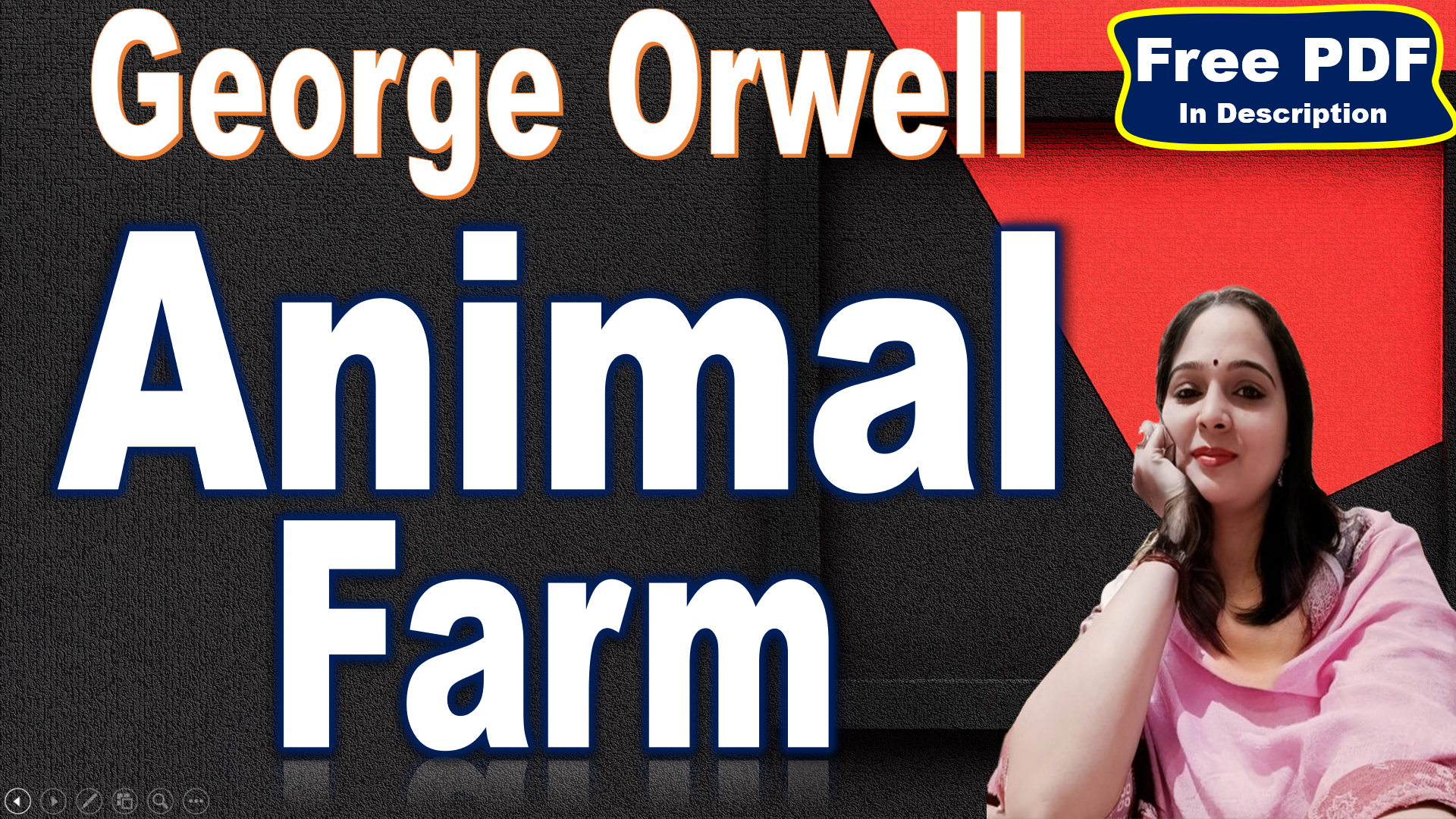George Orwell
Birth and Early Life: George Orwell, whose real name was Eric Arthur Blair, was born on 25 June 1903 in Motihari, Bengal Presidency, British India. He was born into the class of sahibs. His father was a minor British official in the Indian civil service.
Education: Orwell was raised and educated in England from the age of one. He was educated at Eton College.
Career: After school, he became an Imperial policeman in Burma, before returning to Suffolk, England, where he began his writing career as George Orwell. He made a living from occasional pieces of journalism, and also worked as a teacher or bookseller while living in London.
Pen Name: He wrote under the pen name of George Orwell. The surname Orwell was derived from the beautiful River Orwell in East Anglia.
Writing Style: His work is characterized by lucid prose, social criticism, opposition to totalitarianism, and support of democratic socialism.
Notable Works: He is best known for the allegorical novella “Animal Farm” (1945) and the dystopian novel “Nineteen Eighty-Four” (1949). His non-fiction works, including “The Road to Wigan Pier” (1937), documenting his experience of working-class life in the industrial north of England, and “Homage to Catalonia” (1938), an account of his experiences soldiering for the Republican faction of the Spanish Civil War (1936–1939), are as critically respected as his essays on politics, literature, language, and culture.
Personal Life: He was married twice. His first wife was Eileen O’Shaughnessy, whom he married in 1936 and who died in 1945. His second wife was Sonia Brownell, whom he married in 1949. He had one child, Richard Blair.
Death: George Orwell died on 21 January 1950 in London, England.
Legacy: Orwell’s work remains influential in popular culture and in political culture, and the adjective “Orwellian”—describing totalitarian and authoritarian social practices—is part of the English language, like many of his neologisms, such as “Big Brother”, “Thought Police”, “Room 101”, “Newspeak”, “memory hole”, “doublethink”, and “thoughtcrime”.
Characters
Napoleon: Napoleon is one of the two pigs who postulate Old Major’s teachings into “Animalism”. He is a large and rather fierce-looking Berkshire boar. He is the one who becomes the leader of Animal Farm after the Rebellion. His counterpart is Snowball, who is more eloquent and able to get all animals on his side with his ideas and speeches. Napoleon, however, proves more treacherous than Snowball, using his guard dogs to consolidate his power by eliminating his enemies.
Snowball: Snowball is an intelligent, passionate, eloquent pig. He is less subtle and devious than his counterpart, Napoleon. Snowball seems to win the loyalty of the other animals and cement his power. However, he is eventually driven out of the farm by Napoleon and his dogs. He is based on Leon Trotsky, a leader of the Russian Revolution.
Boxer: Boxer is a cart-horse whose incredible strength, dedication, and loyalty play a key role in the early prosperity of Animal Farm. He is not very intelligent—he only learns the first four letters of the alphabet. However, he displays a moral compass that every animal on the farm lacks. He lives by the mottoes “I will work harder” and “Napoleon is always right.”.
Squealer: Squealer is a small, fat pig with very round cheeks, twinkling eyes, nimble movements, and a shrill voice. He is a brilliant and persuasive propagandist who is tasked with justifying Napoleon’s actions and policies to the other animals. He represents the propaganda machine of a totalitarian government.
Old Major: Old Major is the aged and venerable boar who catalyzes the rebellion with his highly influential speech about the evils of humans. His philosophy of Animalism is a mixture of Marx and Lenin. He dies before he can see the result of the rebellion.
Clover: Clover is a stout motherly mare approaching middle life. She supports the revolution, as she naturally takes it upon herself to protect those weaker than she is, and she recognizes this kind of communal spirit echoed in the principles of Animalism.
Mr. Jones: Mr. Jones is the original owner of Manor Farm. He represents the kind of corrupt and fatally flawed government that results in discontent and revolution among its populace. He is overthrown during the Battle of the Cowshed.
Mr. Pilkington and Mr. Frederick: They are the owners of the neighboring farms. They represent the countries that had diplomatic relations with the USSR. However, they find themselves unable to agree on anything.
Benjamin: Benjamin is a donkey, the oldest animal on the farm. He seldom talks and is unchanged by the Rebellion. He is skeptical, cynical, and never laughs. He represents the skeptical people who were unsure of the success of the Russian Revolution.
Mollie: Mollie is a foolish, pretty white mare who drew Mr. Jones’s trap. She likes sugar and wearing pretty ribbons in her mane. She represents the vain and selfish people in Russia who fled to other countries after the Russian Revolution.
Moses: Moses is a tame raven who tells the animals about Sugarcandy Mountain, a heavenly place where animals go when they die. He represents religion.
The Dogs: There are good dogs: Bluebell, Jessie and Pitcher, then there are Napoleon’s dogs that he uses to police the farm. They represent the secret organizations of the police.
The Hens: They bravely protest about their eggs being taken. Their rebellion against Napoleon’s orders symbolizes the resistance and rebellion against oppressive regimes.
The Sheep: They are generally referred to as an anonymous group – no named individual stands out. Their understanding of the aims of the revolution is limited to mindlessly bleating out the slogan ‘Four legs good, two legs bad’. When Squealer decides to alter this, it takes them a week to learn the new version.
Themes
The Corruption of Socialist Ideals in the Soviet Union: “Animal Farm” is a critique of the history and rhetoric of the Russian Revolution. The overthrow of the human oppressor Mr. Jones by a democratic coalition of animals quickly gives way to the consolidation of power among the pigs. The struggle for preeminence between Leon Trotsky and Stalin emerges in the rivalry between the pigs Snowball and Napoleon. The purges and show trials with which Stalin eliminated his enemies and solidified his political base find expression in Animal Farm as the false confessions and executions of animals whom Napoleon distrusts. Although Orwell believed strongly in socialist ideals, he felt that the Soviet Union realized these ideals in a terribly perverse form. His novella creates its most powerful ironies in the moments in which Orwell depicts the corruption of Animalist ideals by those in power.
The Societal Tendency Toward Class Stratification: “Animal Farm” offers commentary on the development of class tyranny and the human tendency to maintain and reestablish class structures even in societies that allegedly stand for total equality. The novella illustrates how classes that are initially unified in the face of a common enemy, as the animals are against the humans, may become internally divided when that enemy is eliminated. The gradual disintegration and perversion of the Seven Commandments illustrates this hypocrisy with vivid force, as do Squealer’s elaborate philosophical justifications for the pigs’ blatantly unprincipled actions.
Totalitarianism: Orwell’s use of Totalitarianism as the theme demonstrates, without education and true empowerment of the lower classes, any revolution led would only be led into oppression and tyranny. Initially, the results of the revolution look promising, as the animals get the direct benefit of their labor. Soon, the pigs adopt human ways and make business deals with farmers that benefit them alone.
Power of Language: Language has the power to engage and disengage. In Animal form, Orwell excellently depicts the power of language through the pigs, only animals with a strong command of language. At the same time, the animals’ adoption of slogans like “Napoleon is always right” or “Four legs good, two legs bad” underlines their lack of understanding and easy to be manipulated nature.
Class structures: From time immemorial class division seems to be a major issue of human society. George Orwell comments on the same through the class division in ‘ Animal Farm ‘ before and after the revolution. He ironically presents the human tendency to have class structures even though they speak of total equality.
Power leading to corruption: “Power leading to corruption” is another major theme Orwell explores in ‘ Animal Farm ’. Many of the characters, predominantly the pigs after the humans demonstrate the theme in the novel. Initially, humans exploit their power over animals. Later following the revolt, the pigs start to fill in the gap created by the eviction of man.
Symbolism
Animal Farm: Animal Farm, known at the beginning and the end of the novel as the Manor Farm, symbolizes Russia and the Soviet Union under Communist Party rule. But more generally, Animal Farm stands for any human society, be it capitalist, socialist, fascist, or communist. It possesses the internal structure of a nation, with a government (the pigs), a police force or army (the dogs), a working class (the other animals), and state holidays and rituals. Its location amid a number of hostile neighboring farms supports its symbolism as a political entity with diplomatic concerns. The farm’s transformation from the Manor Farm to Animal Farm and back to Manor Farm again points to the cyclical nature of societal oppression.
The Barn: The barn at Animal Farm, on whose outside walls the pigs paint the Seven Commandments and, later, their revisions, represents the collective memory of a modern nation. The many scenes in which the ruling-class pigs alter the principles of Animalism and in which the working-class animals puzzle over but accept these changes represent the way an institution in power can revise a community’s concept of history to bolster its control. If the working class believes history to lie on the side of their oppressors, they are less likely to question oppressive practices. Moreover, the oppressors, by revising their nation’s conception of its origins and development, gain control of the nation’s very identity, and the oppressed soon come to depend upon the authorities for their communal sense of self.
The Windmill: The great windmill symbolizes the pigs’ manipulation of the other animals for their own gain. Despite the immediacy of the need for food and warmth, the pigs exploit Boxer and the other common animals by making them undertake backbreaking labor to build the windmill, which will ultimately earn the pigs more money and thus increase their power. The pigs’ declaration that Snowball is responsible for the windmill’s first collapse constitutes psychological manipulation, as it prevents the common animals from doubting the pigs’ abilities and unites them against a supposed enemy. The ultimate conversion of the windmill to commercial use is one more sign of the pigs’ betrayal of their fellow animals.
Food: Food is used to symbolize luxury and inequality. The distribution of food in the novel reflects the status and power of the animals. The pigs, who hold the highest status, are often seen indulging in apples and milk, while the other animals are given minimal rations. This unequal distribution of resources mirrors the class stratification in human societies, where the ruling class often has access to a disproportionate share of resources.
Flags and Rituals: Flags and rituals are used to both galvanize the animals and maintain contro. They serve as tools of propaganda, reinforcing the principles of Animalism and the sense of unity among the animals. They also serve to distract the animals from the inequalities and power dynamics at play. The adoption and manipulation of these symbols by the pigs demonstrate their cunning use of propaganda to control and manipulate the other animals.
The Seven Commandments: The Seven Commandments symbolize the utopian ideals that were the foundation of Animalism. However, as the pigs consolidate power, they manipulate and alter these commandments to justify their actions and maintain their authority, illustrating the corruption of power.
The Dogs: The dogs in “Animal Farm” serve as Napoleon’s private army. They are used to instill fear and maintain order among the other animals, symbolizing the use of force and terror to suppress dissent in a totalitarian regime.
The Hens: The hens symbolize the working class. Their rebellion against Napoleon’s orders to sell their eggs symbolizes the resistance and rebellion against oppressive regimes.
The Sheep: The sheep in “Animal Farm” represent the masses. Their mindless repetition of slogans like “Four legs good, two legs bad” underlines their lack of understanding and easy-to-manipulate nature.
Sugarcandy Mountain: Sugarcandy Mountain, the place where Moses the raven tells the animals they will go when they die, symbolizes the concept of heaven or an afterlife. It represents the religious beliefs that are often used by those in power to control and placate the masses.
Napoleon: Napoleon, the main pig, represents Joseph Stalin. He is known for his blatant lust for power and his method of getting his own way involves a combination of propaganda and terror. His greatest crime is his complete transformation into Jones — although Napoleon is a much more harsh and stern master than the reader is led to believe Jones ever was.
Snowball: Snowball represents Leon Trotsky. He is intelligent, passionate, and eloquent, and he believes in the principles of Animalism. However, he is eventually driven out of the farm by Napoleon and his supporters, who view him as a threat to their power.
Squealer: Squealer represents the disinformation and propaganda efforts of Stalin’s government. He justifies the pigs’ monopolization of resources and spreads false statistics pointing to the farm’s success.
Mr. Jones: Mr. Jones, the original human owner of the farm, represents the ineffective and incompetent Czar Nicholas II. His carelessness and cruelty are the final straw for the animals: they instigate a rebellion when he neglects to feed them and then tries to beat them when they break into the stores of grain.
Boxer: Boxer, the loyal and hardworking horse, represents the working class, who are often exploited by those in power. Despite his loyalty to the cause, Boxer is eventually betrayed by the pigs and sent to the knacker’s yard to be slaughtered.
Clover: Clover represents the female working class and peasants of the Soviet Union. She supports the revolution, as she naturally takes it upon herself to protect those weaker than she is.
Mollie: Mollie represents the bourgeois middle class during the Russian Revolution. Her reluctance to let go of her privileged lifestyle, detachment from the struggles of the working class, and ultimate departure from Animal Farm all symbolize the middle class’s resistance to change and their preference for the comforts of the old regime.
Benjamin: Benjamin represents the intellectuals who failed to oppose Stalin. More broadly, Benjamin represents all intellectuals who choose to ignore politics.
Old Major: Old Major represents a combination of Karl Marx and Vladimir Lenin. His ideas of animal equality and revolution closely mirror Marx’s and Lenin’s ideologies, which laid the foundation for the Russian Revolution.
Moses: Moses, the raven, represents organized religion and the Church. He is depicted as a crafty and opportunistic bird who preaches about Sugarcandy Mountain, a utopian afterlife for animals.
The Seven Commandants
The Seven Commandments in “Animal Farm” are a set of rules initially created by the animals to govern their new society after the rebellion. They are designed to uphold the principles of Animalism and ensure equality among all animals. Here are the original Seven Commandments:
- Whatever goes upon two legs is an enemy.
- Whatever goes upon four legs, or has wings, is a friend.
- No animal shall wear clothes.
- No animal shall sleep in a bed.
- No animal shall drink alcohol.
- No animal shall kill any other animal.
- All animals are equal.
As the story progresses, these commandments are subtly altered by the pigs to justify their increasingly authoritarian rule and to maintain their control over the other animals. The changes are made to serve the interests of the pigs and reflect the corruption of the original ideals of the revolution. By the end of the novel, the commandments have been reduced to a single maxim: “All animals are equal, but some animals are more equal than others,” which signifies the complete betrayal of the revolution’s principles.
The Seven Commandants and its relation to Russian Revolution
“Whatever goes upon two legs is an enemy.”
This commandment reflects the initial revolutionary fervor on the farm, where the animals unite against their human oppressors. In the context of the Russian Revolution, it symbolizes the overthrow of Tsar Nicholas II and the end of the oppressive Tsarist regime.
“Whatever goes upon four legs, or has wings, is a friend.”
This commandment represents the solidarity among the animals, emphasizing their shared struggle against human exploitation. In the Russian Revolution, it parallels the unity among various revolutionary groups and the desire for a better society.
“No animal shall wear clothes.”
This rule underscores the simplicity and equality of Animalism. In the Russian Revolution, it symbolizes the rejection of the aristocracy’s privileges and the aspiration for a classless society.
“No animal shall sleep in a bed.”
This commandment reflects the rejection of human luxuries and comforts. In the Russian Revolution, it represents the desire to eliminate the excesses enjoyed by the ruling class.
“No animal shall drink alcohol.”
This rule emphasizes sobriety and discipline. In the Russian Revolution, it aligns with the Bolsheviks’ call for a focused, committed revolutionary movement.
“No animal shall kill any other animal.”
Initially, this commandment represents the hope for a peaceful, egalitarian society. However, it later changes to “No animal shall kill any other animal without cause,” reflecting the corruption of ideals. In the Russian Revolution, it mirrors the violence and purges that followed the overthrow of the Tsar.
“All animals are equal.”
The ultimate commandment encapsulates the revolution’s promise of equality. However, it evolves into “All animals are equal, but some animals are more equal than others,” symbolizing the betrayal of the revolution’s ideals. In the Russian Revolution, it parallels the rise of a new elite class that exploited the working masses.
Overall, the Seven Commandments serve as a powerful allegory for the Russian Revolution, illustrating how revolutionary ideals can be corrupted and replaced by oppressive regimes, much like the transformation of Manor Farm into Animal Farm and then back into Manor Farm in the novella123.





